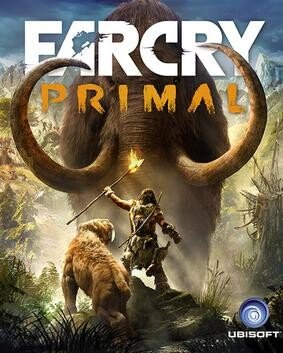The Far Cry games are always such spectacles that it’s hard to look at them critically. They’re a ridiculous amount of fun, so anything they do beyond their consistently solid open world action mechanics is gravy. I’ve always been of the mind that the story of a Far Cry game is a satisfying secondary concern: the gameplay is what drives this franchise, and while certain story points are heavily discussed in media, the bulk of the experience is playing in a big sandbox where things are trying to kill you.
The last four installments of Far Cry have been annual-ish, and whenever that happens two concerns spring to mind: innovation and bug testing. Fortunately, Far Cry Primal succeeds on both counts, and manages to create an experience fresh enough to make it worth being a standalone game as opposed to a DLC offering.
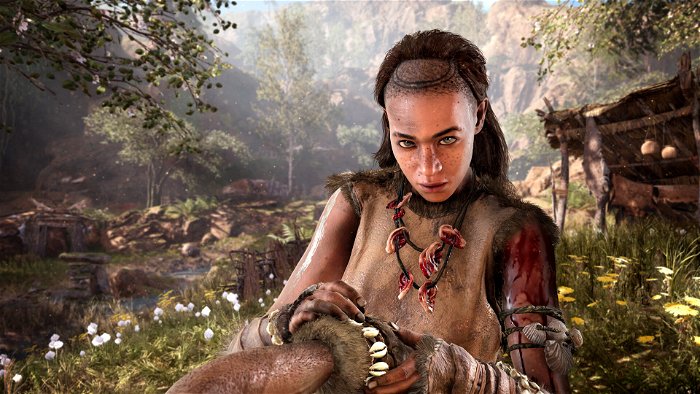
Far Cry Primal takes the Far Cry concept back to the Stone Age… well, technically 10,000 BCE lands in the transition between the Upper Paleolithic and the Mesolithic ages, but really, if you’re trying to put that fine a point on it, you’re taking things too seriously. The timelines of human development are definitely mucked with to support an experience consistent with what fans have come to expect from Far Cry gameplay. The game takes place in Oros, a lush valley just below an Ice Age permafrost where three early human tribes are competing for dominance: the Wenja, the tribe of the playable character, Takkar; the Udam, a more Neanderthal-like, bloodthirsty tribe that still lives in caves; and the Izila, a technologically superior but morally questionable tribe. Because the Izila like to enslave their neighbours and the Udam like to eat theirs, coexistence in Oros just isn’t happening, and it’s up to Takkar to make sure the Wenja come out on top.
The “choose your faction” narrative player choice moments from Far Cry 4 were ditched for Primal, and I was much happier with a simpler story that got out of the way as quickly as possible. The choices that matter in Far Cry games happen within the core open world gameplay: some key fights have an ideal strategy, but there’s a lot of freedom in how to approach most of the game. Want to go in loud and messy? Go for it. Want to be stealthy? You can do that too. Both approaches are satisfying in different ways.

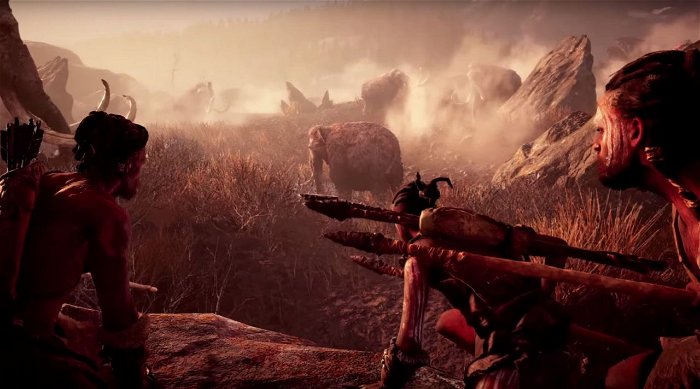
While the map size is comparable to Far Cry 4, there’s a lot more going on between major points of interest. You’re rarely alone when you’re exploring, and the level of open world activity keeps even experienced players on their toes in the early going. Not only does this make navigating between points on the map feel more relevant, but it addresses a concern I had with Far Cry Primal‘s big gameplay shift from previous installments: the beastmaster mechanic. I’m a big animal lover, so I liked the core idea of taming animals to use in-game. I was just concerned that it would wreck the integrity of the game balance. I’m glad that I worried for nothing. The difficulty level is great.
Takkar has an owl that works like an aerial drone, and the ability to control an animal buddy from an ever-growing roster using basic squad commands. This may sound gimmicky, but it works really well. I switched up animals a lot because of their various unique abilities, but I think my favourite critter ended up being the badger, because it’s deliberately played for laughs.
One of the greatest novelties in Primal is how it manages to provide Takkar with an arsenal of weapons with stone age technology. His basic weapon trinity is the club, bow, and spear, which essentially replaces the melee/long range/mid range weapon types of games with guns. Takkar also learns to use throwing dagger-style shard weapons, traps, animal bait, and even primitive bombs—my favorite bomb is filled with bees.
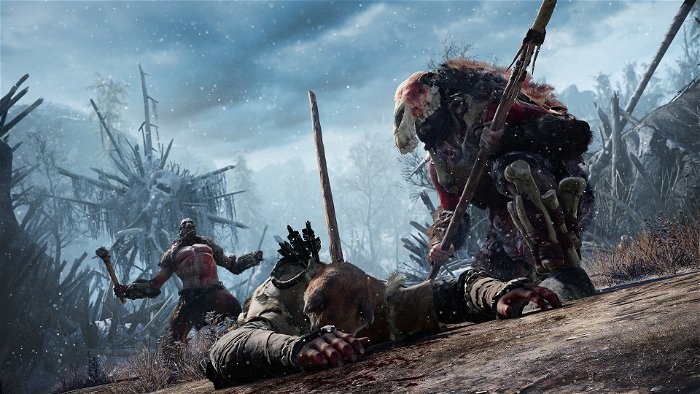
These weapons are all created with a crafting system, and this is the point when experienced gamers start groaning, dreading inventories full of junk you have to carry around to build things while your progress is hampered by one item deliberately in short supply. Ubisoft does things to respect the player’s time in this regard, and cut down on the tedium of crafting.
One of the ways it does this is through Primal‘s primary progress marker: the Wenja village. Building up your village provides you with XP boosts, new abilities, and a visual reward as you watch it grow. It also gives you cumulative resource bonuses that stock at the dawn of each in-game day. This means less grinding for rocks, wood, and animal pelts, and it makes progress much more pleasant.
Your village also functions as a story hub; at the beginning of the game, Takkar’s hunting party is slaughtered by a particularly mean sabretooth tiger, and Takkar escapes to a cave where he meets Sayla, a kind but seriously messed up young woman who likes to wear Udam ears as jewellery. The village they found serves as the spine of the game’s narrative. Sayla’s struggle with insanity is the emotional core of large parts of the game… yes, Far Cry‘s insanity theme is alive and well in Primal. Instead of expecting you to protect the “victimized young woman” character, Primal encourages the player to relate to Sayla.

An additional storytelling challenge is that all of the characters speak some variant of Proto-Indo-European, or PIE. Players are either going to love or hate this element, but for what it’s worth, I thought it added to the experience. There’s a lot of show-don’t-tell going on in Primal, and it’s important to watch carefully the performances in the cinematics and the stuff going on in the background. Primal doesn’t spoon feed you its story and character points. A lot of the meaning is told through gesture, context, and visual design, so your eyes don’t have to be glued to the subtitles. If you get the plot points, great. If you don’t, go whip spears at mammoths; you’ll still have fun.
I enjoyed the subtle ties Primal used to the themes of the Far Cry series, and walked away with the moral that human beings have been killing each other and destroying nature for really dumb reasons for as long as there have been humans. That being said, it still manages to be a life affirming game that works even if you’ve never played Far Cry before. The only character that really needs any explaining for new players is Urki, a comic relief character that fills the required “pothead burnout character” spot. He deliberately sticks out like a sore thumb.
I also want to briefly mention the subtle magnificence of Ubisoft’s new “touched by the world” cinematics. Instead of simulating a movie camera, the cinematics maintain the first-person perspective by mounting a camera on an actor’s head. This leads to some crazy camerawork when the character is spun, flipped, and knocked down, and it adds some visual fresh air to the first-person perspective. Likewise, the game is calculatedly cluttered from an audio perspective, but it somehow manages to avoid turning into sonic sludge or an unpleasant din.
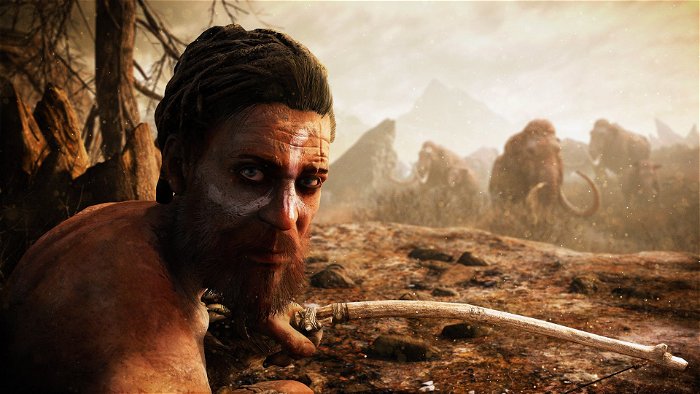
There’s actually so much to praise in Primal that I can’t fit it all in—there’s a lot of game in Primal and my twenty-five hours of play only resulted in 45% mission completion, even though I finished the main story. The lone gameplay frustration I had is the two-part initiation of some of the side quests—I didn’t understand the need for the two-step process, and in the early stages I kept losing the quest markers because the map was so crowded. Everything else played like a dream, and there were no glaring technical bugs. More surprisingly, I didn’t notice any performance issues, and the graphics “pop ins” were rare on my PS4 copy. Primal is a very stable game despite its size.
So if you’re burned out on narrative-heavy games and want a sprawling single-player-only title that makes its mark through gameplay, Far Cry Primal is a fantastic standalone title that also has enough historical research meat to keep history nerds happy. If it sounds fun to set a digital bear on fire then watch it charge through grasslands setting everything ablaze, singing unsuspecting cave men as collateral damage, or if you want to ride a mammoth that tusk punts enemies like ragdoll footballs, you’ll absolutely love Primal‘s approach.
The animals are a definite stand-out in this crowd-pleasing stone-aged action game.

